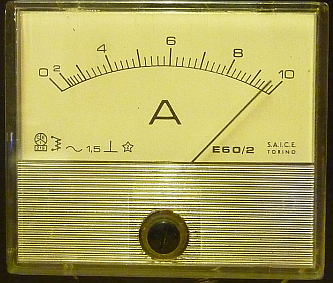In my previous post about published USPTO statistics for utility art units, I promised another blog post listing the utility art units with the smallest backlogs. Here they are:
Continue reading “Utility art units with the smallest backlogs”
In my previous post about published USPTO statistics for utility art units, I promised another blog post listing the utility art units with the smallest backlogs. Here they are:
Continue reading “Utility art units with the smallest backlogs”
In my early days of amateur radio (call sign AA2KW) the way I knew how much current  was flowing in a circuit was by looking at a needle in a d’Arsonval meter. With the meter at right, with the needle as shown you could fairly confidently say the current is 9.6 amperes. But with this kind of meter if the current got too big, the needle would bump against a “peg”. We would say “the meter is pegged” as a shorthand way of saying “the current is so big that it exceeds the range of the meter”. With the meter at right if the needle were at “10”, a person who did not know how mechanical meters worked might mistakenly conclude that the current was in fact 10 amperes. The real situation was that there was a “peg” to keep the needle from swinging further to the right. If the needle happens to be at “10”, the true value might be 12 amps or 20 amps or more.
was flowing in a circuit was by looking at a needle in a d’Arsonval meter. With the meter at right, with the needle as shown you could fairly confidently say the current is 9.6 amperes. But with this kind of meter if the current got too big, the needle would bump against a “peg”. We would say “the meter is pegged” as a shorthand way of saying “the current is so big that it exceeds the range of the meter”. With the meter at right if the needle were at “10”, a person who did not know how mechanical meters worked might mistakenly conclude that the current was in fact 10 amperes. The real situation was that there was a “peg” to keep the needle from swinging further to the right. If the needle happens to be at “10”, the true value might be 12 amps or 20 amps or more.
Which brings us to the point of today’s blog posting. USPTO publishes statistics as to the backlogs for particular art units. In Private PAIR, you can see the backlog for a specific one of your pending files, communicated as a “First Office Action Predication” based upon when your application was filed and which art unit you are in. The FOAP tells you how many months from now that particular application is likely to receive its first Office Action. USPTO also publishes general statistics for each art unit. Recently I wrote about backlogs in the design art units. Now I am going to say a few words about the utility art units with the biggest backlogs including the art units that are “pegged”.
Continue reading ““Pegged”, or, which utility art units have biggest backlogs?”
The USPTO publishes statistics on the size of the backlog for the various art units. Which design art units have the worst backlogs?